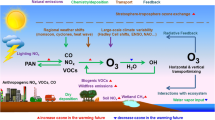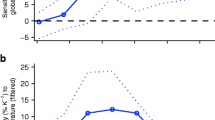Abstract
The water vapor budget and the cloud microphysical processes associated with a heavy rainfall system in the Dabie Mountain area in June 2008 were analyzed using mesoscale reanalysis data (grid resolution 0.03° × 0.03°, 22 vertical layers, 1-h intervals), generated by amalgamating the local analysis and prediction system (LAPS). The contribution of each term in the water vapor budget formula to precipitation was evaluated. The characteristics of water vapor budget and water substances in various phase states were evaluated and their differences in heavy and weak rainfall areas were compared. The precipitation calculated from the total water vapor budget accounted for 77% of actual precipitation; surface evaporation is another important source of water vapor. Water vapor within the domain of interest mainly came from the lower level along the southern boundary and the lower-middle level along the western boundary. This altitude difference for water vapor flux was caused by different weather systems. The decrease of local water vapor in the middle-lower layer in the troposphere during the system development stage also contributed to precipitation. The strength and the layer thickness of water vapor convergence and the content of various water substances in the heavy rainfall areas were obviously larger than in the weak rainfall areas. The peak values of lower-level water vapor convergence, local water vapor income, and the concentration of cloud ice all preceded the heaviest surface rainfall by a few hours.
Similar content being viewed by others
References
Bei, N. F., S. X. Zhao, and S. T. Gao, 2003: A numerical simulation of sudden heavy rainfall occurred in Wuhan and Huangshi during July of 1998. Chinese J. Atmo. Sci., 27, 399–418. (in Chinese)
Chen, B. J., H. Y. Wu, and M. J. Zeng, 2005: Modeling study of cloud and precipitation physical processes of the 5 July 2003 heavy rainfall in Nanjing. Scientia Meteorologica Sinica, 25, 26–31. (in Chinese)
Derbyshire, S. H., I. Beau, P. Bechtold, J. Y. Grandpeix, J. M. Piriou, J. L. Redelsperger, and P. M. M. Soares, 2004: Sensitivity of moist convection to environmental humidity. Quart. J. Roy. Meteor. Soc., 130, 3055–3080.
Ding, Y. H., and G. Q. Hu, 2003: A study on water vapor budget over China during the 1998 severe flood periods. Acta Meteorologica Sinica, 61, 146–163. (in Chinese)
Ding, Y. H., and Y. Z. Liu, 1986: A study on water vapor budget of 7507 typhoon. Acta Oceanologica Sinica, 8, 291–301. (in Chinese)
Etherton, B., and P. Santos, 2008: Sensitivity of WRF Forecasts for South Florida to Initial Conditions. Wea. Forecasting, 23, 725–740.
Feng, Y. R., and H. B. Luo, 1997: On a cumulus convection process in the prefrontal warm sector over Taiwan area. Acta Meteorologica Sinica, 55, 249–256. (in Chinese)
Grabowski, W. W., 2003: MJO-like coherent structures: Sensitivity simulations using the Cloud-Resolving Convection Parameterization (CRCP). J. Atmos. Sci., 60, 847–864.
He, G. F., and Z. J. Hu, 1998: Numerical study on ice seeding in hail storms with various cloud base temperatures. Acta Meteorologica Sinica, 56, 31–45. (in Chinese)
Hiemstra, C. A., G. E. Liston, R. A. Pielke Sr., D. L. Birkenheuer, and S. C. Albers, 2006: Comparing local analysis and prediction system (LAPS) assimilations with independent observations. Wea. Forecasting, 21, 1024–1040.
Holloway, C. E., and J. D. Neelin, 2009: Moisture vertical structure, column water vapor, and tropical deep convection. J. Atmos. Sci., 66, 1665–1683.
Hong, Y. C., and F. F. Zhou, 2005: A numerical simulation study of precipitation formation mechanism of “seeding feeding” cloud system. Chinese J. Atmos. Sci., 29, 885–896. (in Chinese)
Hu, G. Q., and Y. H. Ding, 2003: A study on the energy and water cycles over Changjiang-Huaihe river basins during 1991 heavy rain periods. Acta Meteorologica Sinica, 61, 129–145. (in Chinese)
Jankov, I., P. J. Schultz, C. J. Anderson, and S. E. Koch, 2007a: The impact of different physical parameterizations and their interactions on cold season QPF in the American River basin. J. Hydrometeor., 9, 1141–1151.
Jankov, I., W. A. Gallus Jr., M. Segal, and S. E. Koch, 2007b: Influence of initial conditions on the WRF-ARW Model QPF response to physical parameterization changes. Wea. Forecasting,22, 501–519.
Laing, A. G., and J. M. Fritsch, 1993: Mesoscale convective complexes in Africa. Mon Wea Rev, 121, 2254–2263.
Laing, A. G., and J. M. Fritsch, 2000: The large-scale environments of the global populations of mesoscale convective complexes. Mon. Wea. Rev., 128, 2756–2776.
Liston, G. E., and K. Elder, 2006a: A meteorological distribution system for high-resolution terrestrial modeling (MicroMet). Journal of Hydrometeorology, 7, 217–234.
Liston, G. E., and K. Elder, 2006b: A distributed snowevolution modeling system (Snow Model). Journal of Hydrometeorology, 7, 1259–1276.
Liston, G. E, C. A. Hiemstra, K. Elder, and D. Cline, 2008: Mesocell study area snow distributions for the Cold Land Processes Experiment (CLPX). Journal of Hydrometeorology, 9, 957–976.
McGlinley, J. A., S. C. Albers, and P. A. Stamus, 1991: Validation of a composite convective index as defined by a real-time local analysis system. Wea. Forecast ing, 6, 337–356.
Miller, D., J. M. Fritsch, 1991: Mesoscale convective complexes in the western Pacific region. Mon Wea Rev, 119, 2978–2992.
Ni, Y. Q., and Coauthors, 2011: Establishment and quality evaluation on mesoscale meteorological analysis field in South China Heavy Rainfall Experiment (SCHeREX). Acta Meteorlogica Sinica, doi: 10.1007/s13351-011-0018-7. (in press)
Reisner, J., R. M. Rasmussen, and R. T. Bruintjes, 1998: Explicit forecasting of supercooled liquid water in winter storms using the MM5 meso-scale model. Quart. J. Roy. Meteor. Soc., 124, 1071–1107.
Rothfusz, L. P., and M. R. McLaughlin, 1997: Weather support for the XXVI Olympiad. NOAA Tech. Memo. NWS SR-184, National Weather Service, Southern Region, Fort Worth, TX, 70pp.
Sherwood, S. C., and R. Wahrlich, 1999: Observed evolution of tropical deep convective events and their environment. Mon. Wea. Rev., 127, 1777–1795.
Snook, J. S., P. A. Stamus, J. Edwards, Z. Christidis, and J. A. McGlinley, 1997: Local-domain meso-scale analysis and forecast model support for the 1996 centennial Olympic Games. Wea. Forecasting, 13, 138–150.
Sobel, A. H., S. E. Yuter, C. S. Bretherton, and G. N. Kiladis, 2004: Large-scale meteorology and deep convection during TRMM KWAJEX. Mon. Wea. Rev., 132, 422–444.
Su, Z. J., S. H. Huang, and W. G. Liu, 2000: The micro-physical characteristics of a Huabei cold vortex precipitation. Meteorological Monthly, 26, 16–25. (in Chinese)
Sun, J., and P. Y. Wang, 2003: Numerical study of heavy rainfall in South China with Reisner Graupel scheme. Meteorological Monthly, 29, 10–14. (in Chinese)
Tompkins, A. M., 2001: Organization of tropical convection in low vertical wind shears: The role of water vapor. J. Atmos. Sci., 58, 529–545.
Wang, P. Y., Z. Ruan, and H. W. Kang, 2002: Numerical study on cloud physical processes of heavy rainfall in South China. Journal of Applied Meteorological Science, 13, 78–87. (in Chinese)
Xiao, H., X. B. Wang, F. F. Zhou, Y. C. Hong, and M. Y. Huang, 2004: A three-dimensional numerical simulation on micro-physical processes of torrential rainstorms. Chinese J. Atmos. Sci., 28, 385–404. (in Chinese)
Xu, W. H., Y. Q. Ni, X. K. Wang, X. X. Qiu, X. H Bao, and W. Y. Jin, 2011: A study of structure and mechanism of a meso-beta-scale convective vortex and associated heavy rainfall in the Dabie Mountain area. Part I: Diagnostic analysis of the structure. Advances in Atmospheric Sciences, 28(5), 1159–1176, doi: 10.1007/s00376-010-0170-5.
Yang, J., P. Y. Wang, S. Z. Yang, and B. X. Xu, 2002: Videosonde observations and analyses for cloud micro-physical structures in Mei-yu front precipitation system. Meteorological Monthly, 28, 3–8. (in Chinese)
Zhang, X. H., and Y. Q. Ni, 2010: A diagnostic case study on the comparison between the frontal and non-frontal convective systems. Acta Meteorologica Sinica, 24, 66–77.
Author information
Authors and Affiliations
Corresponding author
Rights and permissions
About this article
Cite this article
Wang, X., Ni, Y., Xu, W. et al. Water cycle and microphysical processes associated with a mesoscale convective vortex system in the Dabie Mountain area. Adv. Atmos. Sci. 28, 1405–1422 (2011). https://doi.org/10.1007/s00376-011-0089-5
Received:
Revised:
Published:
Issue Date:
DOI: https://doi.org/10.1007/s00376-011-0089-5




